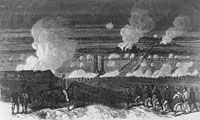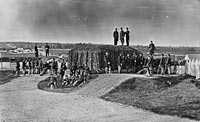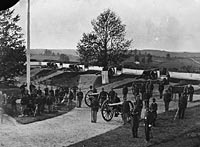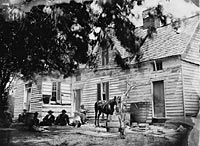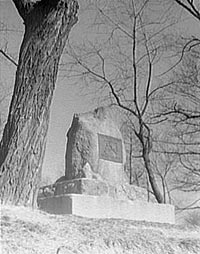During the Civil War, the nation’s capital was ringed by a network of 68 forts and 93 gun batteries which were designed to protect it from Confederate attack from all sides.“Union troops were first stationed “in the vacant squares of the city, but as time went on, and the army continued to grow, they were pushed out into the suburbs, and on the adjoining heights,” noted Frederick W. Seward. “Many of these, under the direction of the engineers, soon became fortified camps and forts. In the course of a few months, every hill around Washington was crowned with an earthwork, and the city was ultimately surrounded by a cordon of fortifications, sixty miles in circumference.”1 Fort Stevens was located in Northwest Washington at the current intersection of Thirteenth Street and Quackenbos Streets. First called Fort Massachusetts, the redoubt was rechristened for General Isaac Stevens, who died in 1862 at the Battle of Chantilly.
According to journalist Noah Brooks, “The line of circumvallation [fieldworks] about Washington was eventually made very strong. With the District of Columbia there were about forty forts, making a complete circle around the capital, their guns being trained to sweep every road or possible route leading into the city. Rifle-pits were cut from point to point, making a continuous line of defense. If the wayfarer or visitor desired a view of something of real war, other than that which might be had in the painful glimpses of dying and wounded brought from battle-fields, or of the grim lines of artillery and troops marching through Washington, a military pass, secured after many difficulties, would enable him to inspect the frowning line of fortifications that inclosed Washington as with a wall.”2
Two concentrated Confederate invasions in 1862 and 1863 had threatened Washington, but the only real attempt to enter the capital occurred in July 1864. General Jubal Early left Richmond with 10,000 troops on June 12. Early marched west to the Shenandoah Valley, northeast through the valley to Maryland. He defeated Union troops at the Battle of Monocacy on July 9 and then marched southeast toward Washington where defense forces were pulled together from invalids, mechanics, clerks and veteran troops rushed to the site from the Richmond front. Historian John F. Marszalek wrote that General Henry W. “Halleck’s mounting panic about what he believed was the inevitability of Jubal Early’s capture of Washington increased the concern of the city’s political leadership” Marszalek noted that “Halleck and the President clearly believed that only Grant could save the save the day.”3 Journalist Noah Brooks reported on the panic in the nation’s capital:
“The city is in a ferment; men are marching to and fro; able-bodied citizens are gobbled up and put in the District militia; refugees come flying in from the country, bringing their household goods with them; nobody is permitted to go out on the Maryland roads without a pass, and at every turn an inquiring newspaper correspondent ins met by some valiant in shoulder straps, pompous and big with importance, in the rear of all danger, with ‘By what authority are you here, sir?’ Last night, while passing by the War Department, I saw an awkward squad of Quartermasters’ clerks drilling in the park. Some were short and some were tall; there were slab-sided clergymen who had forsaken the pulpit for the clerkly desk, fast young men in for a frolic; grim, saturnine men buckled into armor and looking destitute of all friends; men in linen coats and men in half-uniform; these all were being put through the manual by an impromptu captain who, not being very well-informed in such matters, was prompted by his orderly sergeant, a messenger in the War Department.4
As the rebels drew closer, noted Brooks, “The wildest rumors were afloat; all over Washington and Georgetown people were gathered in excited knots, talking over the news and retailing the latest exaggerations from their outer scouts. People began to talk about what they would do with their ‘portables,’…when the rebels should come in.”5 According to Sergeant Smith Stimmel, a member of the president’s bodyguard, “The 11th of July was an anxious day for the President, and for all who knew the situation. During the afternoon of that day the President drove out along the line of some of the forts on the north to investigate the condition of things for himself. I was with the escort that accompanied him on his rounds that day, and it looked to me as though the chances for a scrap were mighty good. I did not see why the Confederates did not make an attack then.”6 As President Lincoln left the White House, he was accosted by Congressman John A. Bingham who inquired if he was fleeing from the approaching Confederate army: “Oh, no, but there is excitement among our boys, and I go out to encourage them.”7 The President observed Early’s attack on Fort Stevens on the outskirts of the city, as recorded by John Hay in his diary on July 11, 1864:
The President concluded to desert his tormentors today & travel around the defenses. [Quincy] Gillmore arrived & reported. Wright & staff also came in.
At three o’clock P.M. the President came in bringing the news that the enemy’s advance was at Ft Stevens on the 7th Street road. He was in the Fort when it was first attacked, standing upon the parapet. A soldier roughly ordered him to get down or he would have his head knocked off. I can see a couple of columns of smoke just north of the White House. It is thought to be Silver Spring in flames — I was at Mr. Blair’s this evening: Fox says Gen. Wright tells him that Silver Spring is not burnt.
The President is in very good feather this evening. He seems not in the least concerned about the safety of Washington. With him the only concern seems to be whether we can bag or destroy this force in our front.
Part of Canby’s troops are here.
Gillmore has been placed in command of them. Aleck McCook is in charge of the defences. There is a great plenty of Generals. Meigs has gone out for a spurt.8
By July 12, regular Union troops from the Sixth Corps had arrived to confront Early’s Confederate veterans. Mr. Lincoln had gone down to greet them as they came off boats on the Potomac River. Historian Charles Bracelen Flood wrote: “After a time Lincoln left the docks and headed for Fort Stevens himself, riding in a carriage. Ahead of him, his cavalry escort was shouting to soldiers and civilians alike, ‘Give the road for the President!’ It became a remarkable scene: the commander-in-chief at the head of his marching soldiers and a great crowd of civilians, all headed out of the city along a wooded road toward the thunderclaps fo cannon fire from an artillery duel already underway.”9
According to Stimmel, “he made a bee line for Fort Stevens, about as fast as the old coach horses could take him, and arrived before the whole of the Sixth Corps got there. On arriving at the Fort, the President left his carriage and took his position behind the earthworks of the Fort, which left us at liberty for the time being to put in the time as we saw fit.” The President stood on the ramparts of Fort Stevens, next to an officer who was wounded. As one soldier reported the incident: “Old Abe and his wife was in the Fort at the time and Old Abe and his doctor was standing up on the parapets and the sharpshooter that I speak of shot the doctor through the left thigh, and Old Abe ordered our men to fall back.”10 Captain Oliver Wendell Holmes, Jr. allegedly shouted at the President: “Get down, you damn fool!” Before the President left the fort, he said good-bye to the future Supreme Court justice, adding, “I’m glad to see you known how to talk to a civilian.” Aide John Hay’s July 12, 1864 diary entry read:
The President seemed in a pleasant and confident humor today. The news from Sherman, if confirmed, is good — that the enemy intend to desert Atlanta.
The President again made the tour of the fortifications; was again under fire at Ft Stevens; a man was shot at his side.
The militia of the District are offering their services and the Department clerks are also enrolling themselves. In Judge Lewis’ office 87 men enlisted and organized themselves in 15 minutes.
Last night the President’s guard of Bucktails was sent to the front.
Mr Britton A. Hill called this evening, in great trepidation, and said he was apprehensive of a sudden attack on the Navy Yard.11
One Union soldier recalled: “General Wright in command of the 6th Corps, stood near [Lincoln] with a field glass, viewing the contest, when a bullet wounded a surgeon nearby. The General turned at once with the order, ‘Mr. President, step down from the parapet, you are too conspicuous an object to remain in so exposed a position.’ Like a good soldier, he obeyed orders and stepped down.”12 Of Holmes’ supposed comment at Fort Stevens, Marc Leepson’s Desperate Engagement,published in 2007, “A close examination of ..the primary source evidence indicates strongly that the story is apocryphal.”13 However, Holmes was an aide de camp to General Wright so it is probable that he was in the fort when President Lincoln visited, according to Broadway critic Alexander H. Woolcott. He was on limited duty after being wounded at the Battle of Chancellorsville the previous year. Woolcott conjectured that the reason that Holmes never spoke of it was “that in after years he heard of so many high-ranking warriors having rescued Lincoln from Early’s snipers that it took him a long time to recover from his distaste.” Woollcott said he tried out his theory on several skeptical dinner parties until he got a positive reception from Supreme Court Justice Felix Frankfurter, who said Holmes had told him the story. Woolcott also heard the story from respected academic Harold J. Laski. As Woolcott reported it, Holmes “told of a day long past when, Lincoln having come out from the White House to inspect the defense, the task of piloting him had fallen to Holmes. Lincoln too wanted to know just where the enemy were, and Holmes pointed them out. The President stood up to look. Now, when standing up and supplemented by his high plug hat, Mr. Lincoln was a target of exceptional visibility. From the rebel marksmen came a snarl of musketry fire. Grabbing the President by the arm, the young officer dragged him under cover, and afterwards, in wave upon wave of hot misgiving, was unable to forget that in doing so he had said, ‘Get down, you fool!’”14
One Ohio soldier later remembered July 12: “President Lincoln visited the fort that afternoon accompanied by Senator [Zachariah Chandler] of Michigan. The enemy was firing lively from the bushes in front of the fort and it was dangerous for any person to look over the parapet. Chandler hugged close to the parapet, but the President was bound he would look over and see what was going on. Soon a sharpshooter fired at him, and he dodged, in doing so tipped over the pass box on which he was sitting and tumbled down. The ball fired at him struck one of the large guns, glanced back and went through a [surgeon’s] soldier’s leg on the look-out. Lincoln gathered himself up and laughing said: ‘that was quite a carom.’ I was standing back of him at the time and was curious to know what a carom meant, and so I asked one of the boys versed in billiards, and he told me…Some of those standing by thought the president was given to a little too much levity and that the remark was a little too jocose for the occasion, but he did not realize what had happened until after he said it.”15
A more complete version of the President’s day is found in the diary entry of Navy Secretary of Gideon Welles, who himself had visited the battle front on both July 11 and July 12. After the second day, Welles wrote:
Went to the President’s at 12, being day of regular Cabinet-meeting. Messrs. Bates and Usher were there. The President was signing a batch of commissions. Fessenden is absent in New York. Blair informs me he has been early at the council chamber and the President told him no matters were to be brought forward. The condition of affairs connected with the Rebels on the outskirts was discussed. The President said he and Seward had visited several of the fortifications. I asked where the Rebels were in force. He said he did not know with certainty, but he thought the main body at Silver Spring.
I expressed a doubt whether there was any large force at any one point, but that they were in squads of from 500 to perhaps 1500 scattered along from the Gunpowder to the falls of the Potomac, who kept up an alarm on the outer rim while the marauders were driving off horses and cattle. The President did not respond farther than to again remark he though there must be a pretty large force in the neighborhood of Silver Spring.
I am sorry there should be so little accurate knowledge of the Rebels, sorry that at such a time there is not a full Cabinet, and especially sorry that the Secretary of War is not present. In the interviews which I have had with him, I can obtain no facts, no opinions. He seems dull and stupefied. Others tell me the same.
It was said yesterday that the mansions of the Blairs were burned, but it is to-day contradicted.
Rode out this P.M. to Fort Stevens. Went up to the summit of the road on the right of the fort. There were many collected. Looking out over the valley below, where the continual popping of the pickets was still going on, though less brisk than yesterday, I saw a line of our men lying close near the bottom of the valley. Senator [Benjamin Wade] came up beside me. Our views corresponded that the Rebels were few in front, and that our men greatly exceeded them in numbers. We went together into the fort, where we found the President, who was sitting in the shade, his back against the parapet towards the enemy.
Generals Wright and McCook informed us they were about to open battery and shell the Rebel pickets, and after three discharges an assault was to be made by two regiments who were lying in wait in the valley.
The firing from the battery was accurate. The shells that were sent into a fine mansion occupied by the Rebel sharpshooters soon set it on fire. As the firing from the fort ceased, our men ran to the charge and the Rebels fled. We could see them running across the fields, seeking the woods on the brow of the opposite hills. It was an interesting and exciting spectacle. But below we could see here and there some of our own men bearing away their wounded comrades. I should judge the distance to be something over three hundred yards. Occasionally a bullet from some long-range rifle passed above our heads. One man had been shot in the fort a few minutes before we entered.
As we came out of the fort, four or five of the wounded men were carried by on stretchers. It was nearly dark as we left. Driving in, as was the case when driving out, we passed fields as well as roads full of soldiers, horses, teams, mules. Camp-fires lighted up the woods, which seemed to be more eagerly sought than the open fields.
The day had been exceedingly warm, and the stragglers by the wayside were many. Some were doubtless sick, some were drunk, some weary and exhausted. Then men on horseback, on mules, in wagons as well as on foot, batteries of artillery, caissons, an innumerable throng. It was exciting and wild. Much of life and much of sadness. Strange that in this age and country there is this strife and struggle, under one of the most beneficent governments which ever blessed mankind and all in sight of the Capitol.16
“As the sun was sinking in the west, the Confederates ceased firing and beat a retreat,” Sergeant Stimmel later wrote. “Our bugle sounded, which meant that the President was ready to return to the city.”17 When Secretary of War Edwin M. Stanton discovered that Lincoln had placed himself in danger on the fort’s ramparts, he reportedly said: “He seems to have lost all sense of his duty to the nation in placing himself as a target for the enemy and especially at a time of the greatest danger to the city and when preparations had been made for his flight in the event of its capture.”18 Treasury official Lucius E. Chittenden recalled that the fort commander was disturbed by the danger in which President Lincoln had placed himself. “The officer said the enemy had already recognized him, he knew, for they were concentrating their fire on him, and a soldier standing near had just been shot through the thigh.” He asked for advice from Chittenden, who told him that you should “send a sergeant and file of men” if the President did not obey orders to move to safer ground. The colonel responded: “I dare not; he is my superior officers. I have taken an oath to obey his orders.” Chittenden convinced him otherwise and the officer told Mr. Lincoln: “Mr. President, you are standing within range of five hundred rebel rifles. Please come down to a safer place. If you do not it will be my duty to call a file of men and make you.” The President responded: “And you would do quite right, my body…you are in command of this fort, and I should be the last man to set an example of disobedience.”19
Lucius Chittenden wrote that had Early captured Washington, he “would have seized the money in The Treasury; the archives of the departments, the immense supplies of clothing, arms, and ammunition in store; he would have compelled General Grant to raise the siege fo Richmond; he would have destroyed uncounted millions in value of property.”20 Historical writer Marc Leepson wrote of Early’s hesitation: “Several factors weighed on his mind. For thing, the bulk of his army was scattered for miles and miles behind him. And every one of his troops labored under the intense heat.” Leepson wrote: “Early judged not to make an assault on July 11, but he did not order a retreat. His men encamped outside Fort Stevens and periodic fierce fighting erupted outside th fort throughout the afternoon and evening. The most intense fighting came after the Sixth Corps troops arrived at Stevens at around 4:00.”10 Journalist Noah Brooks contended the Early’s threat to Washington’s had its desired Confederate effect. He later wrote that “while a great force of effective men was kept at bay within the defenses of Washington, the bulk of Early’s army was busy sweeping up all available plunder, and sending it southward across the Potomac.”
It was popularly believed in the North at that time that President Lincoln was greatly disturbed by the imminence of the danger of the capture of Washington; but I learned from his own lips that his chief anxiety was that the invading forces might not be permitted to get away. Speaking of their escape, afterward, he said that General Halleck’s manifest desire to avoid taking any responsibility without the immediate sanction of General Grant was the main reason why the rebels, having threatened Washington and sacked the peaceful farms and villages of Maryland, got off scatheless.
If Lincoln was the meddlesome marplot in military affairs which some have represented him to be, he would have peremptorily ordered a sortie of the Union forces, then numerously massed inside the defenses of Washington; but although he was ” agonized ” (as he said) over the evident failure of all attempts at pursuit, he kept his hands off. Grant’s distance from the scene, Halleck’s disinclination to take the responsibility of pursuit, and Lincoln’s firm refusal to decide any military question of detail, resulted in the safe departure of Early and his forces. It may as well be said that throughout the long and weary months of the war which followed this panic in Washington, Lincoln frequently referred to the escape of Early as one of the distressing features of his experience in the city of Washington.21
Historian John F. Marszalek noted that the withdrawal of Early’s troops did not relieve Washington. “There was general unhappiness throughout the city about the military response to the Early raid, and the lack of an effective pursuit of the enemy increased the danger. Secretary of War Edwin Stanton became so upset at the lack of command coordination that he had Charles A. Dana, one of his assistants, write Grant insisting that he become more deeply involved in the capital’s defense. David Hunter was commanding troops in the Shenandoah Valley; C.C. Augur was in charge of Washington’s defenses; Horatio Wright commanded VI Corps, which had come to the rescue; Quincy A. Gillmore had temporary command of some other recently arrived troops; and Lew Wallace was in command in Baltimore. ‘But there was no head to the whole,’ Dana concluded. In his letter to Grant, Dana said: Mere ‘advice or suggestions from you will not be sufficient. General Halleck will not give orders except as he receives them; the President will give none, and until you direct positively and explicitly what is to be done, everything will go on in the deplorable and fatal way in which it has gone on for the last week.’”22
Buildings Commissioner Benjamin Brown French wrote in his diary: “The first thing I heard Wednesday was that the invaders were retreating with all their booty, and now we know that they are gone – all got away safe & with whatsoever they captured. It is humiliating enough, and it seems to me as if it ought not to have been permitted. My friend Abraham has got to do something to retrieve this awful blunder or he is ‘a goner!’”23
Footnotes
- Noah Brooks, Washington, D.C., in Lincoln’s Time, p. 22.
- Smith Stimmel, Personal Reminiscences of Abraham Lincoln, p. 56.
- John F. Marszalek, Commander of All Lincoln’s Armies: A Life of General Henry W. Halleck, p. 208.
- Noah Brooks, Mr. Lincoln’s Washington, p. 353-354 (July 12, 1864).
- Brooks, Mr. Lincoln’s Washington, p. 355 (July 12, 1864).
- Don E. Fehrenbacher and Virginia Fehrenbacher, editors, Recollected Words of Abraham Lincoln, p. 31.
- Michael Burlingame and John R. Turner Ettlinger, editors, Inside Lincoln’s White House: The Complete Civil War Diary of John Hay.
- Charles Bracelen Flood, 1864: Lincoln at the Gates of History, p. 196.
- John H. Cramer, Lincoln Under Enemy Fire, p. 27.
- Burlingame and Ettlinger, editors, Inside Lincoln’s White House: The Complete Civil War Diary of John Hay.
- Cramer, Lincoln Under Enemy Fire, pp. 43-43.
- Matthew Pinsker, Lincoln’s Sanctuary: Abraham Lincoln and the Soldier’s Home, p. 140.
- Marc Leepson’s Desperate Engagement, p. 200.
- Alexander Woolcott, “‘Get Down, You Fool!’” Atlantic Monthly, February 1838, pp. 170-173.
- Gideon Welles, Diary of Gideon Welles, Volume II, pp. 74-75.
- Albert E. H. Johnson, “Reminiscences of the Hon. Edwin M. Stanton, Secretary of War, Record of the Columbia Historical Society, Volume 13, 1910, p. 83
- Silas Gamaliel Pratt, Lincoln in story, p. 173.
- Stimmell, Personal Reminiscences of Abraham Lincoln, pp. 64-65.
- Lucius E. Chittenden, Recollections of President Lincoln and His Administration, p. 423.
- Marc Leepson, Desperate Engagement, p. 181.
- Brooks, Washington in Lincoln’s Time, p. 177.
- John F. Marszalek, Commander of All Lincoln’s Armies: A Life of General Henry W. Halleck, pp. 209-210.
- Donald B. Cole and John J.McDonough, editors, Witness to the Young Republic: A Yankee’s Journal, 1828-1870, p. 453.
Visit
Security
Soldiers’ Home
Elihu Washburne
Edwin M. Stanton
Noah Brooks

